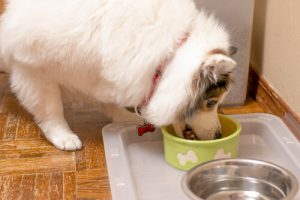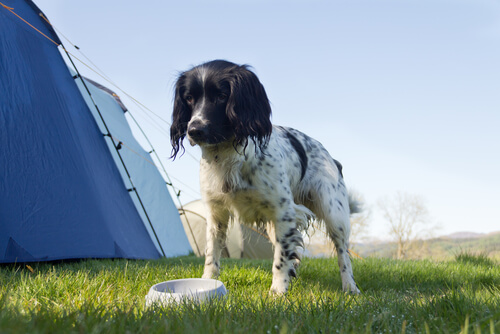3 Handy Tricks with Olive Oil for Your Dog

Olive oil, a product that’s so emblematic of the Mediterranean, never ceases to amaze us with the multiple uses and benefits it provides. In fact, it is useful for both our internal and external health. But we humans aren’t the only ones who can enjoy the many benefits of olive oil. Today, we’ll let you in on the secret of some olive oil-based tricks that can benefit your dog.
Olive oil and dogs, a great combination

Whether you include it as part of your dog’s diet or apply it externally to specific areas of its body, olive oil can be a great ally in improving the health and beauty of your furry friend.
Its naturally-occurring components, such as antioxidants, vitamin E and Omega 3, can be great for your pet. For example, olive oil can:
- Improve the health and appearance of its skin and fur.
- Help it lose excess weight.
- Strengthen its immune system.
- Help it live a longer and healthier life.
Also, although this might seem a little unlikely at first, olive oil is actually something that dogs enjoy eating. But in any case, don’t forget to consult a qualified vet to avoid any potential imbalances in your pet’s diet.
Olive oil can be a great way to solve some specific problems with your dog. Here, we share a number of tricks for issues like constipation, ticks, mange and cracked paw pads.
Some uses of olive oil that will benefit your furry friend
Take note of the following tricks – olive oil might be the perfect way to solve some common problems that your dog may suffer. The remedies we are sharing today are all homemade, natural and healthy options that your pet will be sure to thank you for choosing.
1 – Constipation
If your four-legged friend is having difficulty defecating, try giving him a spoonful of olive oil on an empty stomach. Its laxative properties are very effective, and your dog will likely recover its normal bowel rhythm very quickly.
The oil acts as a grease in the dog’s intestines, and helps any stagnant stools to slide out in a natural way. And what’s more, by using olive oil, you’ll avoid having to treat your dog using any nasty chemicals.
2-Cracked or rough paw pads
Dogs’ paws are like their shoes. And while they of course have to be tough to deal with all the surfaces dogs usually walk on, there are times when they can become cracked or rough.
If this happens, a good option to them is to spread a bit of olive oil on the affected area with your fingers once a day for about a week.
And to prevent the dog from licking the soles of its feet or leaving nasty oil stains all over the house, it’s a good idea to put some socks on its paws for a while after applying the oil.
3 – Scabies and ticks
If you apply olive oil externally to areas affected by mange, the nests of the mites that produce it are slowly destroyed. And what’s more, the treatment will moisturize the skin of your furry friend, whose fur has been dried out by the infection.
Olive oil is also an ingredient that can help you get rid of ticks quickly and easily. Once you locate one of these annoying parasites, you should moisten the area with a little olive oil. Wait for a few seconds, move the fur out of the way and, if necessary, use a pair of tweezers to remove the tick, always pulling in the same direction as the grain of your dog’s fur.
Olive oil in your dog’s diet

As you can see, olive oil never ceases to amaze us with the many possibilities it offers for the health and beauty of humans and animals alike. And it will be a staple of any Mediterranean diet worth its salt.
But keep in mind that if you plan to incorporate this food into your dog’s daily diet, you should consult a specialist in animal nutrition to show you the best way to do it.
Bear in mind that a diet that is over the top and supplies too many calories can be as bad as one that leaves things out, so be sure to find out if all of your dog’s nutritional needs are covered by what you are feeding it.
And if you give your dog homemade food, ask the professional to specify how much olive oil you can include in the dog’s diet according to its size, age and any other specific characteristics it may have.
This text is provided for informational purposes only and does not replace consultation with a professional. If in doubt, consult your specialist.